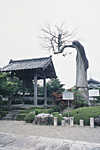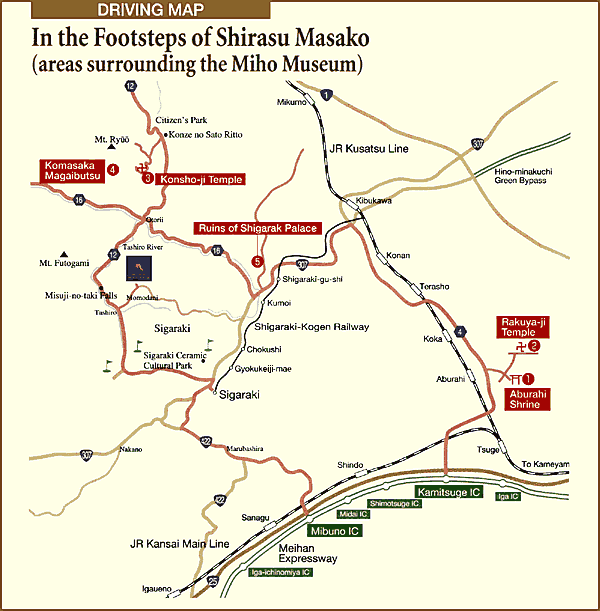| 1 |
Aburahi
Shrine
Location: Aburahi, Koka, Shiga
prefecture
Transportation: Approx. 2.5 km
from Aburahi Station on the JR Kusatsu Line; 40 km from the Ritto
Interchange on the Meishin Expressway; 7 km from Kamitsuge on the
Nishimeihan Expressway.
Parking: 30 spaces
Charge: Free
Koga-cho Museum of History and Ethnography
Adults: 200 yen Children: 100 yen (reservation required)
History: Mt. Aburahi (649m), near
the southern edge of the Suzuka mountain range, is a sacred mountain.
Long ago, Aburahi Daimyojin, the God of fire, is said to have descended
to the peak of this mountain, causing an intense light to be seen.
Mt. Aburahi's name derives from this event, "Abura" meaning
oil and “hi” meaning fire. The local Aburahi Shrine was
built in association with the inner shrine on the top of the mountain.
It is one of the few genuine examples of shrine architecture in Shiga
Prefecture. The main shrine, the prayer hall, the two-storied gate
and the corridor have been designated as Important Cultural Assets
|
 |
2
|
Rakuya-ji
Temple
Location: Ichiino, Koka, Shiga
prefecture
Transportation: 6km east of JR
Koka Station; 4km north of JR Aburahi Station; Approx. 40km from the
Ritto Interchange on the Meishin Expressway along National Highway
Route 1 (in the direction of Suzuka).
Charge: 300 yen
History: During the reign of Emperor
Kanmu in the 11th year of the Enryaku era (792 AD), the priest who
founded the temple on Mt. Hiei came to the village of Koka to gather
materials for the construction of a hall. Every time he swung his
sword, he bowed three times, and then carved a statue from a live
tree. This became the principal object of worship at the temple and
is the largest statue of a sitting, eleven-headed Kannon Bosatsu in
Japan. |
 |
| 3 |
Konsho-ji
Temple
Transportation: Climb the opposite road of the Konze no Sato Station
on Prefectural Highway Route 12 and take the left fork of the three-pronged
mountain road. Note that this road is too narrow for oversized vehicles.
Parking:
Available.
History: This temple is located
close to the summit of Mt. Konze (566.8m). The priest Roben founded
it during the Nara Period (687-773 AD). Later, the priest Gan-an built
a monastery on the top of the mountain to pray for the nation's peace
and tranquility. Later the temple became an imperial prayer site. |
| 4 |
Komasaka Magaibutsu
Transportation: Approx. one-hour walk from Konsho-ji Temple
History: The Magaibutsu statue,
carved from one massive stone, stands in the mountains near Mt. Konze
on the ruins of Komasaka Temple. The Temple was constructed during
the Konin era (810-824 AD) by the priest Gan-an of the Kofuku-ji Temple
in Nara at the same time that the Konsho-ji Temple first opened. In
a huge granite rock seven meters in height and four meters in width,
three main figures are depicted. In the center is a sitting Amida
Buddha accompanied on either side by a standing Kannon bosatsu and
a Seishi bosatsu. Twelve other bosatsu surround this triad. |
| 5 |
Ruins of Shigaraki Palace
History: Shigaraki Palace was
built by Emperor Shomu in the Tenpyo era (742 AD). It heralded the
creation of the Great Buddha at Todai-ji Temple in the old capital
of Nara. |
|
